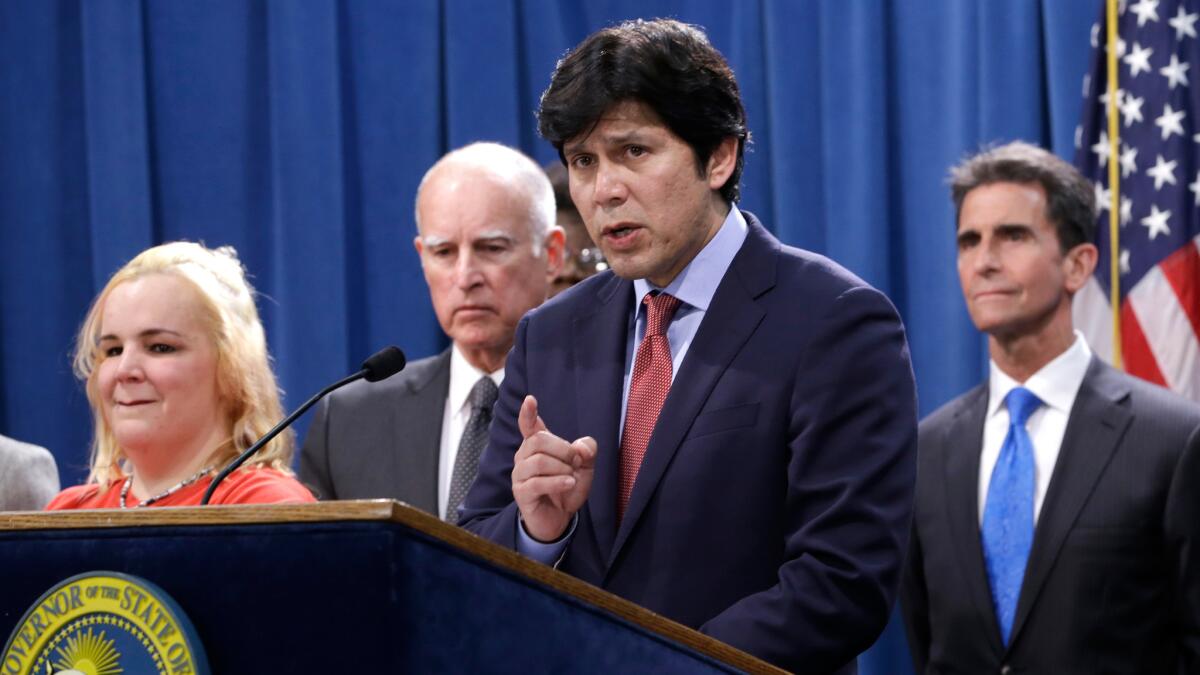Editorial: Legislature should give the green light to state’s new retirement savings plan

- Share via
As California moves closer to launching a retirement savings program for workers at companies that don’t offer retirement plans of their own, some Wall Street firms are trying to hit the pause button. Their warnings are overblown, however, and state officials should keep moving forward.
The Secure Choice savings program would create individual retirement accounts for up to roughly 7 million workers in California at companies with five or more employees that do not offer a pension, 401(k) plan or similar retirement benefits. Workers would initially contribute 3% of their wages, and a state board could gradually increase the rate to 8%. Their IRAs would stay with them if they changed jobs, and they could opt out at any time (even at the beginning). As with other IRAs, they could face a tax penalty if they tapped the money before they retired.
Most of those eligible for the program would be low- to moderate-wage workers, given that employers with higher pay scales typically have their own retirement plans. And so the savings a worker would accumulate through Secure Choice would probably be modest — assuming a 5% annual return, a $50 monthly contribution would build up to about $42,000 after 30 years. But when added to Social Security benefits, the money would help keep more retirees out of poverty and off public support. More than 1 in 5 California seniors lives in poverty, according to the Census Bureau’s Supplemental Poverty Measure — the worst rate in the country. And the ranks of the impoverished retirees in California have grown dramatically over the last 15 years, according to the Sacramento Bee.
The Legislature set the wheels in motion in 2012 when it approved a bill by Sens. Kevin de León (D-Los Angeles) and Darryl Steinberg (D-Sacramento) creating a board to evaluate the feasibility of the Secure Choice program. Aided by a consultant, the board analyzed whether the program could sustain itself without posing any risk to the taxpayers (as required by state law).
The board agreed in March that Secure Choice could work as intended, with no liability or cost to the taxpayers. The U.S. Labor Department has issued a tentative rule setting guidelines for state-run programs such as Secure Choice, and the Treasury Department has said the IRAs offered through the program would qualify for the same tax benefits as other IRAs. Since then, the Senate has approved a bill by De León to start implementing the program Jan. 1, on the condition that it complies with the Labor Department’s final guidelines and other federal requirements. Eligible employees would be phased in over time, starting with those at the largest employers.
Granted, workers would be better off with a pension, a 401(k) or other plan that received contributions from their employers too. And by establishing Secure Choice, the state would be doing something workers can already do for themselves, just by filling out some paperwork with a mutual fund company to create an automatic investment in an IRA.
But thousands of employers aren’t offering retirement plans, and far too many workers aren’t setting up IRAs. The Secure Choice board can also negotiate lower IRA fees than workers could obtain on their own. That’s a big deal — high fees can trim several percentage points and thousands of dollars off of a saver’s returns.
Nevertheless, in a letter this month to Brown, the mutual funds’ trade group — the Investment Company Institute — warned that the Secure Choice program posed a number of risks and carried “substantial unforeseen costs.” These include the possibilities that the program will not comply with the federal law governing employer-sponsored plans, that the Secure Choice board will be subject to onerous and costly federal regulations that apply to investment advisors and that taxpayers will have to bail out the program if it doesn’t live up to the promise it makes to savers.
Yet De León’s bill and the 2012 law that envisioned the Secure Choice program include a number of safeguards against these and other pitfalls. For example, if the program doesn’t qualify for an exemption from the federal Employee Retirement Income Security Act, it won’t launch. Nor can it legally offer plans for which taxpayers might be held liable, unless the board goes back to the Legislature and gets permission.
It’s understandable why the Investment Company Institute would want to protect its members from having to compete with state governments. But the Secure Choice board is a potential customer, not a would-be rival. Rather than managing retirement investments itself, the board will put that work out for bid by mutual fund companies and other investment firms that already have that expertise. Left to their own devices, those companies have failed to reach millions of Californians. That’s why the state should step in and help push more workers to save for their retirement.
Follow the Opinion section on Twitter @latimesopinion and Facebook
More to Read
A cure for the common opinion
Get thought-provoking perspectives with our weekly newsletter.
You may occasionally receive promotional content from the Los Angeles Times.







